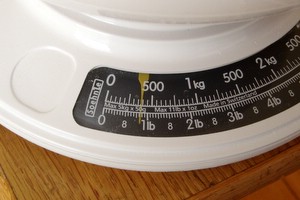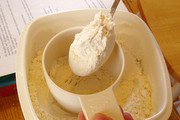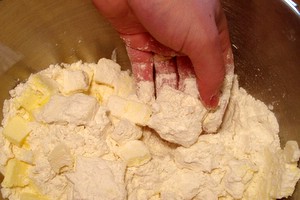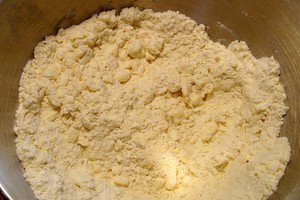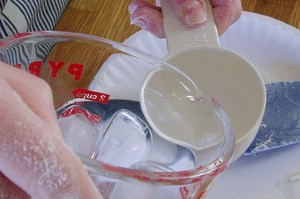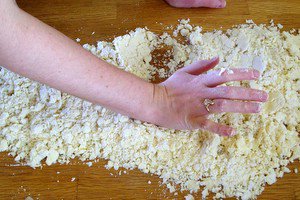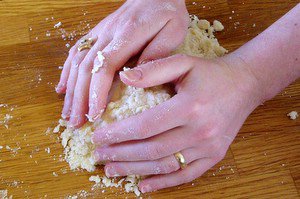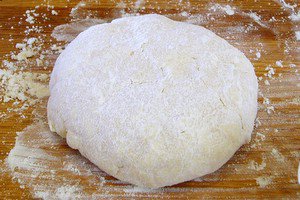
I first saw asparagus on the packet of McCormick's Hollandaise sauce. We were invited for dinner to Nancy and Howard’s – an American family who was helping us adjust to our new country when we moved here in ’91. I was 13, and found US fascinating, particularly all the interesting foods. Baltimore suburbs were not what you’d consider a culinary destination, particularly in the early 90s. But I didn’t know that. All I knew was that this place had 5 brands of butter, cool fruits like mango, and strawberries in December -- completely unheard of in Russia at the time. So when I saw Nancy cooking asparagus and then pouring the yellow sauce from the special packet all over it, I was intrigued.
What was even more intriguing was that her kids wrinkled their noses when asparagus dish reached them, and passed it on without a moment’s hesitation. Since I was determined to try everything at least once, I plopped a few slippery spears that threatened to fall apart onto my plate. I barely managed to cut these mushy sticks into bite-size pieces. Not only were they mushy, they were stringy too. When I finally got to tasting one of them, I learned that Nancy’s kids were right. These frog-colored sticks were pretty bad.
US has gone through such a culinary revolution in the past 15 years that it’s hard to believe it’s the same country. You can now find celery root and sorrel in many supermarkets, figs are found not only in Fig Newtons, and restaurants serve duck liver and sweetbreads. By now, asparagus is as exotic as potato. And yet, most asparagus served as home is still the same brownish stringy mush it was 15 years ago. Most men and children still hate it, and most women righteously cook it (or dare I say overcook it) and pretend to like it because it’s good for you.
So, throw away that asparagus steamer (it’s a useless piece of equipment) and get ready to cook all the wonderful spring asparagus that’s now in season.
Trimming asparagus:It’s best to trim asparagus by breaking off the thick end of each spear. It will naturally break at the spot where it is tender. Cutting the ends off with a knife will make it hard to guess just how much to take off since it varies from one spear to the next.
Peeling asparagus:Peeling asparagus is optional and labor intensive. If you ask me it affects the presentation more than the taste. But if you want a perfectly delicate spear from tip to toe, you might want to peel the bottom 2 inches.
Unlike carrots and potatoes that are best peeled while being held in one hand, asparagus is easiest to peel while it’s lying on your work surface. Start 2 inches from the thick end and peel towards the end of the spear. Rotate the spear with your other hand and clean off your peeler after each spear. In my opinion, this tricky procedure is only worth it if you are blanching asparagus.
 Method 1: Blanching
Method 1: Blanching (cooking in boiling water and then shocking in ice-bath)
This cooking method results in crisp, delicate, and refreshing asparagus.
Fill a large skillet with 2 inches of water and bring to a boil. Season generously with salt and add 1/4 tsp rice vinegar or lemon juice (this helps asparagus stay green).
Prepare a large bowl of water with ice.
Add asparagus to boiling water and spread it out in a pan. Cover and bring to a boil. Cook just until you can pierce its thick end with a fork, but still encountering a trace of resistance, about 2 minutes. Err on the side of undercooking.

Immediately remove asparagus with tongs and place in prepared ice water (this stops the cooking process instantly and prevents asparagus from overcooking).

Cool completely. Remove from water, and dry well on paper towels.

My favorite way to serve blanched asparagus is chilled as a first course or a side salad. This really shows of its crispness and freshness. Whisk together 1 Tbsp lemon juice, 1/4 tsp Dijon mustard (optional), and 3 Tbsp good olive oil. Season with salt and pepper. Arrange asparagus on a plate, sprinkle with a little kosher salt and drizzle with lemon vinaigrette. You can serve it as is, or top with lemon zest and finely shredded parmesan.
 Method 2: Pan-frying
Method 2: Pan-fryingThis cooking method results in full-flavored asparagus with great caramelisation. If you are going to convert someone into an asparagus lover, this is the way.
Set a large skillet over high heat. Add 2 tsp olive oil. Place asparagus in a pan in one layer and cook until one side is browned, about 2 minutes.

Turn asparagus with tongs to let the other side brown, about 2 minutes. Cook asparagus until bright green on all sides, constantly tossing it with tongs, about 1 minute.

Make sure to keep the spears lined up in the same direction during the whole time (this ensures they all get in contact with the pan).
Sprinkle with a little kosher salt and remove from pan.
You can serve pan-fried asparagus hot as a side dish or chilled as an appetizer. Try drizzling with a little balsamic vinaigrette or wrapping it in prosciutto – yum!

Whatever you do, don't cook asparagus in advance and "keep warm" as McCormick's suggests -- that's what makes it mushy and stringy. It only takes 5 minutes to make. So cook it last minute and serve immediately, or cook in advance and serve it chilled.
 The gorgeous weather we've been having in Boston makes me want to drop everything and spend every waking moment outside (or in the kitchen cooking the spring veggies). You know what this means, don't you? I might have to do the unthinkable and spend a bit less time blogging. Gasp!
The gorgeous weather we've been having in Boston makes me want to drop everything and spend every waking moment outside (or in the kitchen cooking the spring veggies). You know what this means, don't you? I might have to do the unthinkable and spend a bit less time blogging. Gasp!
 I first saw asparagus on the packet of McCormick's Hollandaise sauce. We were invited for dinner to Nancy and Howard’s – an American family who was helping us adjust to our new country when we moved here in ’91. I was 13, and found US fascinating, particularly all the interesting foods. Baltimore suburbs were not what you’d consider a culinary destination, particularly in the early 90s. But I didn’t know that. All I knew was that this place had 5 brands of butter, cool fruits like mango, and strawberries in December -- completely unheard of in Russia at the time. So when I saw Nancy cooking asparagus and then pouring the yellow sauce from the special packet all over it, I was intrigued.
I first saw asparagus on the packet of McCormick's Hollandaise sauce. We were invited for dinner to Nancy and Howard’s – an American family who was helping us adjust to our new country when we moved here in ’91. I was 13, and found US fascinating, particularly all the interesting foods. Baltimore suburbs were not what you’d consider a culinary destination, particularly in the early 90s. But I didn’t know that. All I knew was that this place had 5 brands of butter, cool fruits like mango, and strawberries in December -- completely unheard of in Russia at the time. So when I saw Nancy cooking asparagus and then pouring the yellow sauce from the special packet all over it, I was intrigued.







 While surfing the food blogosphere this Friday afternoon, I stumbled on
While surfing the food blogosphere this Friday afternoon, I stumbled on  Until last summer, most of the food blogs intimidated me. They had stunning photography that looked like something out of Gourmet and clever stories that their authors churned out 4-5 times a week. How on earth did they manage to do that while having a full-time job simply amazed me.
Until last summer, most of the food blogs intimidated me. They had stunning photography that looked like something out of Gourmet and clever stories that their authors churned out 4-5 times a week. How on earth did they manage to do that while having a full-time job simply amazed me. When your computer dies on a monday night, you know it's not going to be a good week. If you've been wondering why it's been so quiet on Beyond Salmon, that's why. Having to re-install windows and all my applications, dealing with physical therapy appointments for my back, vet appointment for our cat, and craziness at work was just too much. I don't mean to bore you with my whining, but is it friday yet? Sometimes you need an emergency weekend.
When your computer dies on a monday night, you know it's not going to be a good week. If you've been wondering why it's been so quiet on Beyond Salmon, that's why. Having to re-install windows and all my applications, dealing with physical therapy appointments for my back, vet appointment for our cat, and craziness at work was just too much. I don't mean to bore you with my whining, but is it friday yet? Sometimes you need an emergency weekend. I had some Aioli (garlic mayo) left after the Provence class that I taught this weekend, and I was looking for a good use for it that didn't involve bread. Don't get me wrong -- aioli spread on a good toast is pure heaven. But it would take a lot of bread to use up all my aioli, and calories (even consumed in heaven) do count. That's when swordfish came to the rescue. Marinating it in oil is a great trick for making it juicy and tender. And what is mayo, but a whole bunch of oil?
I had some Aioli (garlic mayo) left after the Provence class that I taught this weekend, and I was looking for a good use for it that didn't involve bread. Don't get me wrong -- aioli spread on a good toast is pure heaven. But it would take a lot of bread to use up all my aioli, and calories (even consumed in heaven) do count. That's when swordfish came to the rescue. Marinating it in oil is a great trick for making it juicy and tender. And what is mayo, but a whole bunch of oil?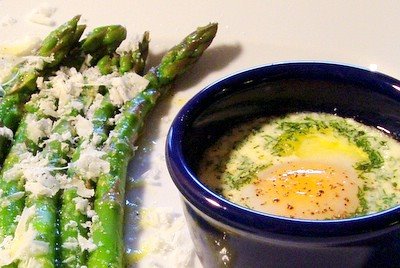 What do you eat when you are home alone? Everyone has some favorite food that the rest of their family can't master any enthusiasm for. Mine is not some obscure organ meat or strange animal -- Jason eats all of those. It's not even beets -- he started eating those about a year ago. It's simply eggs. Poor guy had a bad childhood experience at his friend's house with an egg casserole that scarred him for life. So, no eggs in our house for breakfast -- not sunny side up, not scrambled, not poached, and definitely not in a casserole.
What do you eat when you are home alone? Everyone has some favorite food that the rest of their family can't master any enthusiasm for. Mine is not some obscure organ meat or strange animal -- Jason eats all of those. It's not even beets -- he started eating those about a year ago. It's simply eggs. Poor guy had a bad childhood experience at his friend's house with an egg casserole that scarred him for life. So, no eggs in our house for breakfast -- not sunny side up, not scrambled, not poached, and definitely not in a casserole.







 Looking at my Outlook schedule last monday morning was depressing enough to start drinking office coffee. It was burnt and just plain bad, and it wasn't going to help me deal with the insane number of meetings I had that week, but still... And then the phone rang. Am I late somewhere already? After looking at the caller ID, I breathed a sign of relief. It was my Mom. "You have a minute?" All our conversations start this way, and I am yet to have one that actually took a minute. "Sure!" how could I say no to procrastinate dealing with customers and developers.
Looking at my Outlook schedule last monday morning was depressing enough to start drinking office coffee. It was burnt and just plain bad, and it wasn't going to help me deal with the insane number of meetings I had that week, but still... And then the phone rang. Am I late somewhere already? After looking at the caller ID, I breathed a sign of relief. It was my Mom. "You have a minute?" All our conversations start this way, and I am yet to have one that actually took a minute. "Sure!" how could I say no to procrastinate dealing with customers and developers.

 Actually, the first question is not "how," but "why." So, why would you cook a whole fish? The same reason you’d cook a whole chicken – when the flesh is cooked on the bone, it tastes juicier and more flavorful. It also allows you to enjoy small fish that would turn out rather dry if filleted before cooking, like Mediterranean sea bass (branzino), and Sea Bream (dorado). Contrary to the belief of most cooks, preparing a whole fish is not a laborious undertaking. Here is how.
Actually, the first question is not "how," but "why." So, why would you cook a whole fish? The same reason you’d cook a whole chicken – when the flesh is cooked on the bone, it tastes juicier and more flavorful. It also allows you to enjoy small fish that would turn out rather dry if filleted before cooking, like Mediterranean sea bass (branzino), and Sea Bream (dorado). Contrary to the belief of most cooks, preparing a whole fish is not a laborious undertaking. Here is how.













